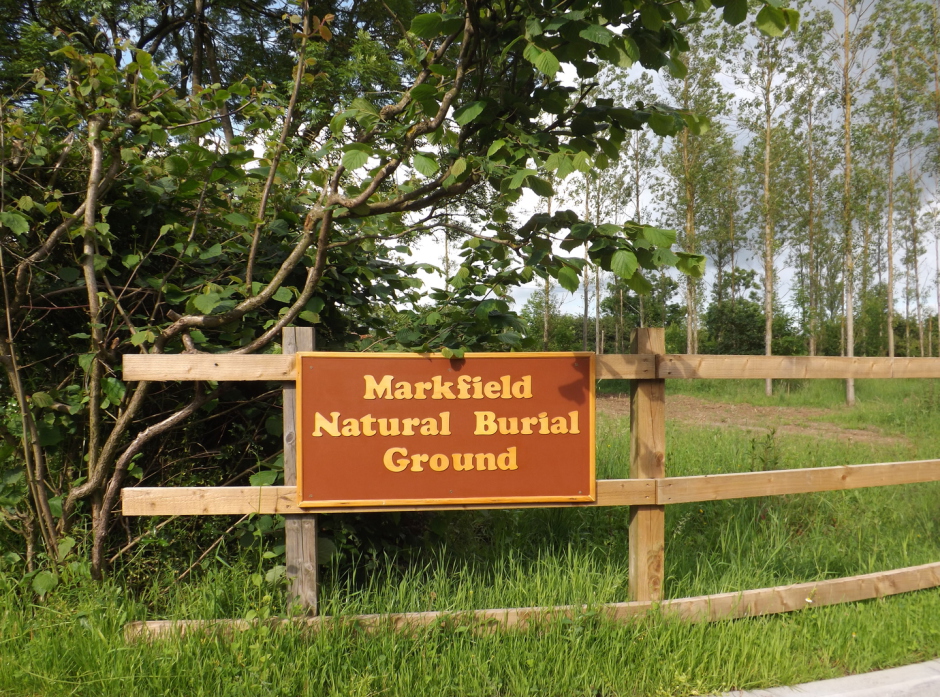The Nature Reserve
 The Oak tree in the centre of the burial area
The Oak tree in the centre of the burial area
Natural burial is a gentle and environmentally friendly route for those who are unfortunately having to make funeral arrangements. Those of us who are
concerned that our final resting place should have as little impact on the environment as possible and those who wish to leave behind a protected corner of England will find this a positive and
comforting choice.
So creating a Nature Reserve to co-exist within the same patch of ground is an ideal way of ensuring the ongoing,
beneficial usage of the ground. The two activities complement each other totally.
Markfield Natural Burial Ground and Nature Reserve has been created on 15 acres of land that
were for years good quality arable land. Then in 1997, for reasons that we don’t understand, a monoculture poplar plantation was created. The land was not adequately cared for, and became
overgrown and inaccessible. When the opportunity to buy it occurred, it was gratefully seized with both hands.
We pitched our idea to Hinckley and Bosworth District Council, and then the Ecology
Department of Leicestershire County Council. The idea was to remove the poplar trees and the dense undergrowth of mainly bramble, and replace it with a selection of firstly deciduous, broad
leaved trees and traditional hedging plants, secondly mid height herbs and shrubs, and finally areas of grassy glades and rides. This three phase concept provides the greatest degree of cover and
food sources for small mammals, birds and insects, and creates a sustainable food chain. English woodland flowers are sown at appropriate times of the year.
Leicestershire County Council Ecology Department proposed other ways of improving the
environment. They gave us lists of the most beneficial tree types and hedging plants, suggested cutting back areas immediately around the ponds, and hanging bird and bat boxes in the trees and
hedges. Brash piles (piles of cut back vegetation) were also suggested – these provide food for insects, and shelter for voles, mice and hedgehogs, amongst other animals.
Our introduction page already lists the range of avian, mammalian and insect life that we
have seen on the land, but repetition would do no harm - swifts, swallows, kestrels, buzzards, sparrowhawks, jays, magpies, crows, woodpeckers, cuckoos, sparrows, yellowhammer, blackbirds, wrens,
thrushes, robins, frogs, roe deer, foxes, pheasants, dragonflies, damselflies, snails, slugs, spiders, beetles, bees and wasps, can all be seen and heard.
 Damselflies are spectacular
Damselflies are spectacular
And the point of all this ? Well, it is a great environment to work in, and there is
immense satisfaction in creating a refuge that is so beneficial to both flora and fauna. And if the concept of Natural Burial is one that appeals, then we think you will love what we are
creating just outside Markfield. As a final place of rest it is serene and placid, punctuated mainly by the calls of the birds and animals that are fast adopting it as a residence. The existing and
new plants are thriving, and a green oasis is springing up. Sun and shade and short walks are available, and no time limits are imposed.
It is a place that will be pleasant to visit, and maybe take a picnic to, or just spend a
lazy summer evening watching the swallows and swifts diving and swooping on their insect prey, and marvel at their soundless flying skills. In the autumn, listen to the cackling of the pheasant as
they prepare for winter, and watch the geese arriving from Siberia to overwinter on Thornton Reservoir. Crows and buzzards squabble in flight year round. Pigeons appear out of nowhere – and disappear
just as fast. Wrens and robins perch nervously in the hedgerows, and then soundlessly disappear. The activities of the wildlife are a relaxing backdrop to quiet contemplation.
 Jays provide a flash of colour, and a distinctive "cuckling" sound
Jays provide a flash of colour, and a distinctive "cuckling" sound
Please be aware that this is an ongoing project. The creation and maintenance of Markfield Natural Burial Ground and
Nature Reserve is a bit like the maintenance of the Forth Road Bridge – it is never ending – as soon as one job is finished, it is necessary to do another. At various times of the year there are
maintenance and improvement tasks to be carried out. Cutting back the poplar trees, removing the bramble, planting new hedges and trees, the bi-annual cutting back of the hedges, the maintenance of
the 6 metre rides around the perimeter of the land, grass cutting, foot path maintenance -the list goes on. We try to do this at times when people are less likely to visit – ie during the
weekday, when there are no burial ceremonies happening, but please understand if we are working when you arrive to visit. Maintenance work will not be carried out when there are ceremonies in progress.
 Roe deer - blink and you will miss them - they come and go silently, and are very shy
Roe deer - blink and you will miss them - they come and go silently, and are very shy

